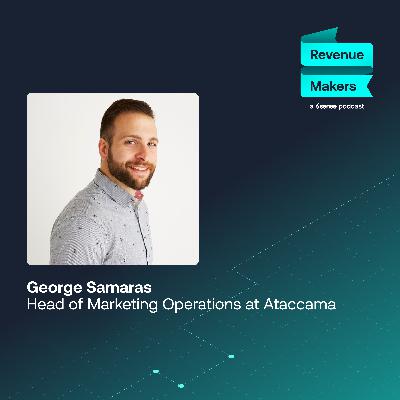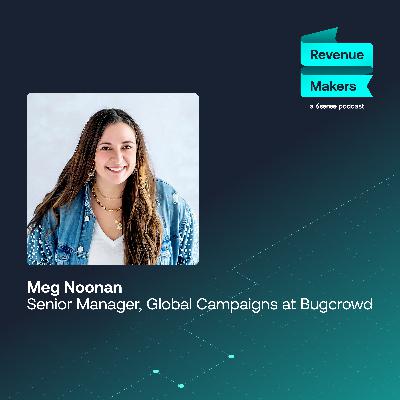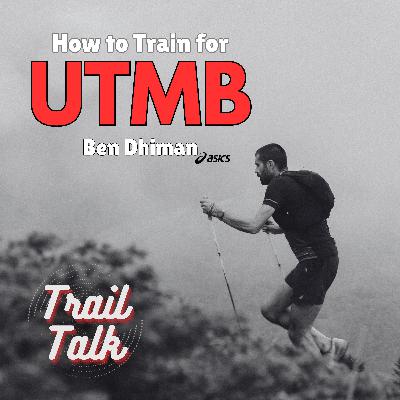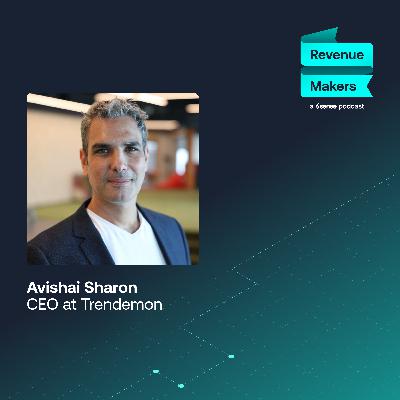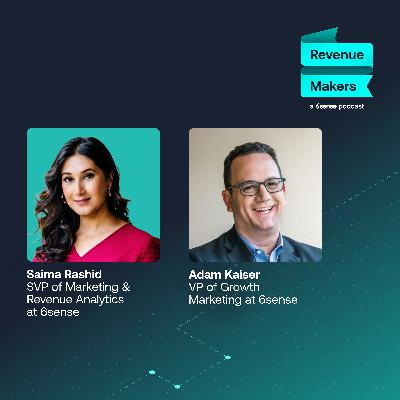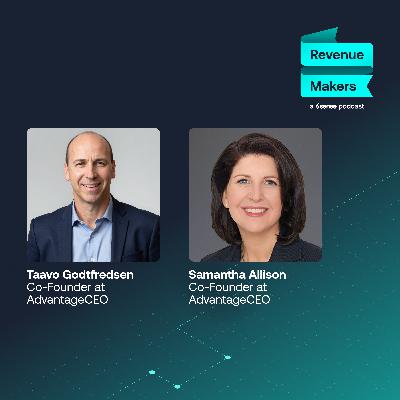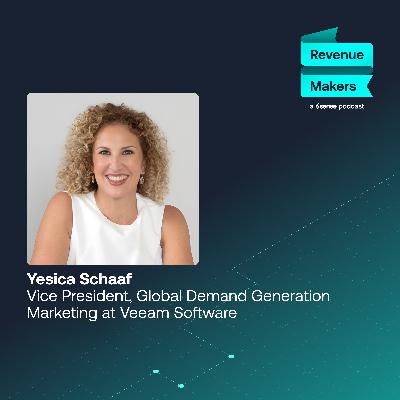Discover Revenue Makers
Revenue Makers

Revenue Makers
Author: 6sense
Subscribed: 5Played: 125Subscribe
Share
© 2025
Description
There's so much noise when it comes to marketing and sales strategies, and it can be hard to differentiate between the junk and what will actually drive impact. We’re here to help make sense of the nonsense.
Through conversations with other revenue leaders, we’re going to explore the projects and campaigns they’ve executed to drive their business forward.
Whether mundane or illogically ridiculous, we’ll share key insights as we break down how, and why, they were successful in making revenue.
Proudly brought to you by 6sense, let’s make sense of the strategies others have tried so you can be one step ahead of the rest.
Through conversations with other revenue leaders, we’re going to explore the projects and campaigns they’ve executed to drive their business forward.
Whether mundane or illogically ridiculous, we’ll share key insights as we break down how, and why, they were successful in making revenue.
Proudly brought to you by 6sense, let’s make sense of the strategies others have tried so you can be one step ahead of the rest.
82 Episodes
Reverse
When precision meets passion, LinkedIn advertising takes off.In this episode, AJ Wilcox, founder of B2Linked, joins Adam Kaiser to discuss what's new and what’s next for LinkedIn Ads. AJ shares how years of managing campaigns for some of LinkedIn’s biggest advertisers shaped his approach to targeting, measurement, and ROI. He zooms in on how improved reporting tools and better-quality data are helping marketers shift budget from search to social with confidence.He’s helping brands rethink LinkedIn strategy, avoid costly pitfalls, and use personalization and thought leadership ads to connect more authentically, proving that when it comes to B2B, relevance always wins.In this conversation, you’ll learn:How B2B marketers are shifting ad spend from search to LinkedIn for higher-quality leadsWhy personalization and thought leadership ads are driving the next wave of performance on LinkedInHow to avoid the five most common (and costly) LinkedIn Ads mistakesWhy understanding LinkedIn’s new measurement tools is key to proving ROIJump into the conversation:
(00:00) Introducing AJ Wilcox
(01:09) How AJ built B2Linked into a LinkedIn-only agency
(02:18) Why LinkedIn delivers unmatched lead quality for B2B marketers
(03:41) How budgets are shifting from Google to LinkedIn
(05:10) Building a full-funnel LinkedIn strategy that drives conversions
(07:00) How LinkedIn’s new Revenue Attribution Report changes ROI tracking
(09:10) Using third-party data like 6sense to boost targeting precision
(12:00) The five most common mistakes marketers make on LinkedIn Ads
(15:57) Improving conversion tracking with LinkedIn’s Conversion API
(18:53) The rise of thought leadership and personalized ad formats
(21:00) How to scale your LinkedIn strategy efficiently
(22:46) The most ridiculous request AJ’s ever experienced
When marketing meets finance, the data gets real.In this episode, George Samaras, Head of Marketing Operations at Ataccama, joins Adam Kaiser to zoom in on what happens when marketing ops reports directly to the CFO.George explains how being part of the finance org reshaped his view of marketing metrics, moving from campaign performance to pipeline impact and revenue accountability. He also outlines how Ataccama’s RevOps model unites marketing, sales, and customer success around one shared source of truth for better GTM visibility.You’ll hear how he’s helping bridge the gap between creative strategy and financial outcomes, what he’s learned about efficiency from the finance lens, and why marketers need to start thinking in terms of dollars, not just engagement.In this conversation, you’ll learn:How sitting under finance changes the way marketing ops measures successWhy marketers should frame results around revenue generation or cost savingsHow RevOps alignment improves data visibility and decision-makingWhy financial fluency is becoming a must-have skill for modern marketersJump into the conversation:(00:00) Introducing George Samaras(01:03) Why marketing ops now reports to finance at Ataccama(03:57) How financial alignment changes marketing measurement(05:49) Evaluating MQLs, pipeline, and event ROI(07:14) How AI and SEO shifts are impacting acquisition strategy(08:14) Attribution challenges and in-house solutions using Salesforce and 6sense(10:02) Lessons from sitting under the CFO’s org(11:17) How finance influences marketing budgets and ROI analysis(13:30) Why marketing ops needs to think like finance(14:51) Acting as “Switzerland” between marketing and finance(16:35) How shared data builds credibility for marketing(18:17) The most unrealistic request George has ever received
Most deals are won long before the competition even shows up.In this episode, Meg Noonan, Senior Manager of Global Campaigns at Bugcrowd, joins Adam Kaiser to discuss how her team runs competitive takeout campaigns that get ahead of rivals before they make a move.Meg zooms in on how Bugcrowd uses intent data to spot competitors early, reach out first, and craft messaging that focuses on solving buyer pain points and not tearing others down. She explains how third-party reviews and customer testimonials back up every claim, and why thoughtful enablement is key to helping sales teams execute with confidence.In this conversation, you’ll learn:How competitive takeout campaigns win when paired with a strong content strategyHow intent data helps spot competitors and prospects earlyWhy pain points and proof outperform competitor bashingWhy reaching out first can be the dealmaker in competitive salesJump into the conversation:
(00:00) Introducing Meg Noonan
(02:02) How intent data helps identify competitors and key opportunities
(04:35) Crafting messaging that focuses on buyer pain points vs. competitor bashing
(07:00) The role of testimonials and hard data in competitive takeout campaigns
(10:04) Mapping content to the buyer’s journey from awareness to decision
(12:15) Key lessons from successful competitive campaigns at Bugcrowd
(16:04) Advice for teams hesitant about launching competitive takeouts
(18:35) Meg’s experience with luxury retail and a Chinese delicacy
Half of today’s B2B buyers are now starting their journey inside an LLM instead of Google.In this episode, Sydney Sloan, Chief Marketing Officer at G2, joins Adam Kaiser to unpack how AI is reshaping the buying process and what that means for marketers. She shares insights from G2’s latest buyer behavior study, including the rapid rise in LLM adoption, and explains how the shift from SEO to what she calls “answer engine optimization” is changing where and how brands show up.Sydney also breaks down how G2 is adapting its content and review strategies to meet this new reality, why integrating review generation into the product experience is a winning formula, and what leaders can do to keep pace in an AI-first world. From redefining KPIs to rethinking website design, she highlights the competitive advantage of acting early and building trust where buyers now start their search.In this conversation, you’ll learn:Why 50% of buyers are starting their search with LLMs instead of GoogleWhy review strategies and user-generated content are critical in the “answer economy”How marketers can adapt content, KPIs, and websites for an AI-first buying journeyHow AI-driven buyer behavior is shortening sales cycles and shrinking vendor shortlistsJump into the conversation:
(00:00) Introducing Sydney Sloan
(03:09) Buyer behavior shift from Google to LLMs
(06:50) Decline of SEO and rise of answer engine optimization
(09:34) Building content strategy around jobs to be done
(14:46) New review strategies including AI voice reviews
(20:58) How leaders can adapt go-to-market strategies in an AI-first world
(27:52) Fun career stories
When AI cranks out faster campaigns and copycat content, brand and creativity are your only edge.In this episode, Bruno Bertini, Chief Marketing Officer at 8x8, joins Adam Kaiser to share how his team launched ‘The Power of You’ campaign, a bold brand play that put customers at the center and proved that AI can amplify creativity rather than dilute it.Bruno walks through the thinking behind the rebrand, why differentiation in SaaS can no longer rely on product alone, and how 8x8 used AI-powered production to create customer stories that were fun, emotional, and memorable, all while cutting through a crowded B2B space.In this conversation, you’ll learn:Why 8x8 chose to differentiate through brand instead of productHow ‘The Power of You’ campaign put customers in heroic roles while telling authentic storiesWhy AI lowered production costs and expanded creative possibilitiesHow brave marketing can help B2B teams build human connection and stand outJump into the conversation:
(00:00) Introducing Bruno Bertini
(01:55) Understanding 8x8
(04:38) Rebranding and differentiation through marketing
(07:01) The Power of You campaign: Concept and execution
(13:49) Customer reactions and AI integration
(16:58) Campaign results and impact
(19:29) Future plans and expanding the campaign
(22:32) Advice for marketing teams: Be brave
The website isn’t dead, it’s evolving into something far more powerful.
In this episode, Avishai Sharon, CEO of Trendemon, joins Adam Kaiser to explore how B2B companies can transform their websites into engines of personalization and buyer engagement. Avishai zooms in on why websites are an underutilized goldmine of signals, how to distinguish between page-level and journey-level personalization, and what it really takes to create an “always-on” experience that adapts to buyers in real time.
He explains how AI and LLM-referred traffic are reshaping digital journeys, why informed visitors convert at higher rates, and what marketers can do to both influence buyer perceptions and educate the engines themselves.
In this conversation, you’ll learn:Why the website is still central to buyer engagement and how it’s shifting from static to active roleThe difference between page-level and journey-level personalization, and why the latter matters most for scaleHow to map and segment content assets to align with industries, personas, and buying stagesWhy LLM-referred visitors behave differently and how to optimize their experienceJump into the conversation:
(00:00) Introducing Avishai Sharon
(01:14) The myth of the dead website
(01:31) Understanding website personalization
(01:56) Leveraging signals for better engagement
(02:46) The role of the website in buyer journeys
(03:40) Challenges and opportunities in signal utilization
(08:41) Page level vs. journey level personalization
(12:00) Mapping content to buyer personas
(14:13) Always-on marketing strategies
(16:36) The impact of AI and LLM traffic
(18:12) Addressing misconceptions and optimizing buyer experience
Reaching the 75th episode is more than a milestone, it’s a moment to look back at the evolving world of marketing, AI, and what’s next for revenue leaders.
In this episode, Adam Kaiser and Saima Rashid reflect on the impactful conversations they've had with guests over time. From AI-driven marketing to human-focused sales tactics, they share key moments that have shaped the show.Adam and Saima highlight memorable episodes, including their conversations with Seth Godin, Leah Davidson, and Tricia Gelman. They zoom in on the evolving role of AI in B2B marketing, including the rise of zero-click search and the implications for SEO strategies.
In this conversation, you’ll learn:How AI is transforming marketing and sales strategiesWhy AI fluency is now a must for marketing teamsThe impact of zero-click search on SEO and content strategyHow CMOs are adapting to AI-powered workflows and processesJump into the conversation:
(00:00) Introduction
(01:07) Pop culture and podcast milestones
(03:01) Memorable guests and episodes
(03:17) Seth Godin's impactful insights
(04:25) Sales and marketing alignment
(07:07) The rise of zero click search
(09:22) SEO in the age of AI
(12:07) Content strategy for modern marketing
(14:34) AI in organizational structures
(20:54) A look back at the journey of growth and collaboration
PE-backed leadership comes with big expectations and big opportunities.
In this episode, Samantha Allison and Taavo Godtfredsen, co-founders of AdvantageCEO and authors of The 5X CEO, join Adam and Saima to share how top-performing leaders consistently deliver 5X+ returns for investors. Backed by interviews with over 75 high-performing CEOs, their five-part framework reveals how leaders can beat the odds, scale smarter, and build enduring value.
Sam and Taavo zoom in on the five pillars of the 5X model which are strategic clarity, scalable talent, relentless focus, disciplined execution, and energized culture, and how each one plays a critical role in driving performance during the high-stakes hold period.
In this conversation, you’ll learn:Why 50% of PE-backed CEOs don’t make it through the hold period and how to be in the other halfHow to connect every role to the investment thesis and value creation planWhat “relentless focus” looks like in action How to scale yourself and your team without burning outJump into the conversation:
(00:00) Introducing Taavo Godtfredsen and Samantha Allison
(05:41) The 5X Model
(08:56) Adapting to PE ownership
(15:41) PE firm's role in strategic planning
(27:55) Scalable talent in action
(30:51) Unique CEO stories
(34:30) Combating burnout
Shifting to buying groups isn’t just a strategy change. It’s a cultural shift that touches everything from campaigns to content to measurement.
In this episode, Yesica Schaaf, VP of Global Demand Generation Marketing at Veeam, joins Adam and Saima to break down how her team made the leap from a traditional lead-based model to a fully operational buying group motion, and why ripping the band-aid was the best decision they made.
Yesica shares the end-to-end transformation, starting with persona research and content mapping all the way through to building a new measurement model and redefining campaign execution. She also explains how Veeam is treating AI not just as a content tool, but as an actual member of the buying group and what that means for the future of marketing strategy.
In this conversation, you’ll learn:Why Veeam shifted to a buying group model and how they got startedHow they identified and filled content gaps across personas and the buyer journeyHow they evolved their measurement model, including buying group scoring and attributionWhy AI is now considered a “persona” in their buying groupsJump into the conversation:(00:00) Introducing Yesica Schaaf
(01:13) Transition to B2B buying groups
(02:01) Case study introduction
(05:22) Initial strategy and personas
(07:21) Content mapping and gaps
(11:48) Execution with 6Sense
(13:24) Cultural and measurement changes
(15:05) Implementing new technologies
(17:55) Lessons learned from the transition
(19:41) Future of buying group engagement
Imagine integrating AI into your marketing strategy to automate workflows and drive measurable results across your team.In this episode of Revenue Makers, Rachel Truair, CMO at Simpro Software, shares her experience of embedding AI within her marketing organization. Rachel talks about her team’s shift from initial AI experimentation to fully operationalizing AI. She highlights how AI is now embedded in everything her team does, from optimizing workflows to building better customer personas. She also gives practical examples of how AI tools are transforming processes, increasing efficiency, and enhancing customer insights.
In this conversation, you’ll hear about:The cultural shift required to adopt AI across marketing teamsHow AI is used to automate workflows, campaigns, and inbound outreachThe importance of data-driven decision-making and how AI supports this processThe role of AI in voice of the customer initiatives and digital twins for persona-buildingJump into the conversation:
(00:00) Introducing Rachel Truair
(01:37) The importance of AI experimentation
(03:42) From foundational to operational AI
(05:32) Cultural shifts and AI integration
(07:55) Voice of the customer and digital twins
(17:03) AI in content creation and SEO
(19:17) Building a competitive moat in AI search
(23:38) Experimentation and team dynamics
(24:39) AI-Driven campaigns and web strategy
(29:11) Automating outbound and inbound outreach
What if your marketing budget could actually build pipeline instead of just plug holes?In this episode of Revenue Makers, Alana Hass, Head of Integrated Campaigns and Growth Marketing at FireMon, shares her 20 years of experience in B2B tech marketing. She discusses the value of strategic budget planning, the role of consistent brand messaging in long-term growth, and how marketing budgets should be viewed as investments in trust and pipeline. Alana also explores the evolving landscape of growth marketing and the need for cross-functional collaboration.In this conversation, you’ll hear about:The importance of planning marketing budgets for consistency and long-term impactHow brand trust is essential for building pipeline and opportunitiesThe interplay between brand, demand, and growth marketingReal-world examples of how consistent brand messaging drives resultsJump into the conversation:(00:00) Introducing Alana Hass (02:30) Why marketing budgets should focus on long-term consistency(05:10) The impact of human behavior on B2B buying decisions(08:00) How brand trust drives pipeline growth(11:20) Balancing short-term needs with long-term brand-building(13:40) The role of cross-functional teams in growth marketing(16:00) Showcasing brand impact through measurable results(19:15) Real-world examples of growth marketing at FireMon(22:00) Aligning marketing and sales for maximum impact(25:10) How consistent branding shapes strategy and results
Sales and marketing alignment may sound straightforward, but it’s often reduced to process charts and dashboards, rather than focusing on the people doing the work.
In this episode, Lia Davidson, CMO at EAB, joins Adam and Saima for a refreshingly honest conversation about what real alignment looks like inside complex organizations. She shares how building trust with sales didn’t come from structure or incentives, but from solving problems together and staying radically candid.
Lia also unpacks the moment she realized marketing needed to stop celebrating metrics that didn’t match sales outcomes—and how shifting to shared KPIs changed everything. Plus, why personality tests, casual hangs, and a simple phone call can outperform strategy offsites.
In this episode, you’ll learn:Why marketers should rethink their funnel language to reflect real sales impactHow to lead with empathy when functional teams aren’t getting along
What happens when marketing and sales review pipeline togetherHow to create team alignment without reporting lines or reorgsJump into the conversation:
(00:00) Introducing Lia Davidson and sales-marketing alignment
(02:47) The human side of misalignment and why process alone doesn’t fix it
(04:38) How Lia’s early sales experience shaped her approach as a CMO
(06:44) A people problem disguised as a pipeline problem
(08:15) The offsite that solved misalignment without touching strategy
(10:19) Why marketing can’t claim green if sales is red
(12:52) How Lia celebrates marketing wins while staying tied to revenue
(14:32) Building one team without a shared reporting structure
(18:59) Why “one funnel mentality” is more than just a slogan
AI is changing how marketing teams work, but it’s not just about new tools — it’s about shifting mindsets and building a true partnership between humans and AI.In this episode, Liza Adams, a former big tech marketing executive turned AI and marketing advisor, shares how she helped a marketing team transform by integrating AI “teammates” alongside humans. With 25 marketers and 25 AI agents working together, this case study demonstrates how AI can deliver real value by automating repetitive tasks, enhancing creativity, and enabling more informed decision-making.Liza breaks down how to start small with AI, aligning use cases with business goals and leaning into early adopters who inspire the rest of the team. She also emphasizes the importance of AI literacy and empathy in managing fears and resistance while sharing practical tips on integrating various AI tools to minimize errors and enhance outcomes. This episode goes beyond theory, providing a grounded examination of how AI is reshaping marketing organizational charts and workflows as we speak.In this episode, you’ll learn:What it means to think of AI as a teammate, not just a toolHow to identify the best AI use cases by aligning with strategic priorities or pain pointsWays to build AI literacy and manage change with empathyTips for combining AI models to reduce hallucinations and improve accuracyJump into the conversation:
(00:00) Introducing Liza Adams and the AI teammate concept
(05:30) Real AI use cases transforming marketing workflows
(09:00) Aligning AI projects with strategic initiatives
(11:00) Case study: shrinking human headcount, growing AI agents
(15:40) Overcoming fear and resistance through empathy and education
(18:10) AI literacy as foundational for smart adoption
(20:20) Legal and policy considerations in AI rollout
(25:00) Practical prompts and ways to reduce AI hallucinations
(28:30) Career moments and marketing myths busted
Events have always been a powerful way to connect, but in the world of B2B marketing, they often don’t get the recognition they deserve as a proper growth channel. Today, event-led growth is making a strong comeback, particularly as people yearn for genuine human connection in a tech-heavy, AI-driven world. When done right, events become much more than a one-time experience. They are strategic moments that drive revenue, build relationships, and fuel pipeline growth.In this episode, Kate Hammitt, VP of Marketing at Cvent and an event marketing veteran, shares insights from her extensive experience running events, from the US Open to major trade shows. She breaks down how event-led growth is evolving, why rigor and data are crucial, and how to create events that not only deliver exceptional experiences but also generate ongoing value through content and follow-up. Kate also shares smart tips on measuring success, curating the right audience, and using personalization to make every event meaningful.In this episode, you’ll learn:What event-led growth means, and why it needs a clear strategyHow to measure event success beyond just attendance and anecdotesWays to use data and AI to personalize and elevate event experiencesPractical advice for identifying gaps in your buyer’s journey where events can add the most valueJump into the conversation:
(00:00) Introducing Kate Hammitt and event-led growth
(05:19) Defining event-led growth and the role of strategy
(07:24) Post-event follow-up and measuring impact
(09:30) What makes a good event
(10:22) Content creation and attendee experience
(12:04) Trends in personalization and peer connections
(15:06) How clients are shifting event budgets and formats
(16:23) Using data and AI to personalize events
(19:04) Kate’s favorite events and career highlights
(20:22) Advice for starting or scaling an event program
How does a company transform its market potential by tapping into the latest technology?In this episode, Tricia Gellman, CMO of Box, shares how the company expanded its addressable market by $40 billion through AI integration. She discusses the need for new products, messaging, team structure, and partnerships. Tricia highlights the rapid changes in AI for content management and the importance of aligning sales, marketing, and customer success to win over new and existing personas.The conversation highlights innovative AI use cases, such as recruiting automation and sales contract creation, emphasizing the importance of developer engagement. Tricia discusses navigating rapid change and the significance of adaptability and celebrating successes.In this episode, you’ll learn:How AI is opening up a $40 billion market for BoxThe role of unstructured data in driving AI valueWhy Box is moving from on-premise to AI-driven solutionsJump into the conversation:(00:00) Introducing Tricia Gellman(02:35) Box expands into $40 billion AI market(04:17) Disrupting on-prem solutions with AI-driven content(06:49) Organizing transformation in the AI era(10:22) Rethinking buyer personas and IT’s role(14:46) Adapting sales and CS for new narrative(18:21) Real-world AI agents emerging in HR(21:25) Enabling agent collaboration for sales efficiency(25:17) Marketing shifts to developer engagement strategy
A successful brand refresh is more than just a new look. It’s about aligning your messaging, visuals, and product to tell a cohesive story. But getting there requires careful planning, clear ownership, and a deep understanding of what’s changing.In this episode, Saima Rashid and Adam Kaiser share the inside story behind 6sense’s brand refresh. They’ll explore how aligning messaging with product architecture drove design decisions, the importance of maintaining core elements, and how to avoid pitfalls in the process.In this episode, you’ll learn:What teams often get wrong when updating their brandHow to measure impact across product, marketing, and sentimentWhy clarity in ownership and timing makes or breaks the process
Jump into the conversation:
(00:00) The time to refresh
(02:32) Signs it’s time for a brand refresh
(04:29) How AI and M&A shaped the story
(06:36) Rebrand vs. refresh and why it matters
(08:22) The new design system of grids and glows
(13:26) Why messaging needs to lead the change
(20:31) Key metrics to measure brand impact
How can businesses maintain their competitive edge while adapting to rapid technological changes?In part two of conversation, Seth Godin, author of This Is Strategy, shares his insights on strategy, innovation, and the transformative impact of AI. He explains how to balance strategic commitments with the flexibility needed to respond to new opportunities. Seth addresses the potential pitfalls of relying too heavily on AI for efficiency and discusses the importance of creating added value for customers.The conversation also explores the distinct roles and mindsets necessary for navigating an uncertain landscape. Getting into the differences between tactics and strategy, Seth illuminates how empowering teams can lead to innovative solutions.In this episode, you’ll learn:
1. How to balance flexibility with strategic commitment
2. Why empathy is essential in both strategy and leadership
3. How to leverage AI to create long-term value, not just cut costsJump into the conversation:
(00:00) Introducing Seth Godin
(02:41) Empowering frontline tactics in luxury service
(04:52) Marketers' role in AI integration
(06:16) Permission marketing in the AI era
(10:29) Understanding product adoption lifecycle
(12:39) Strategic advantage through unique actions
(14:20) Facing competitive landscapes with empathy
(17:08) Personalizing long-term strategic planning
(19:52) Frameworks for effective strategy communication
(22:01) Relying on market feedback and resilience
How do you lead with strategy in a fast-changing world?In this episode, Seth Godin, author of This Is Strategy, joins Saima Rashid and Adam Kaiser for part 1 of a two-part conversation. Seth discusses his latest book, This is Strategy, and how it challenges traditional views of what strategy really is. He explains why strategy isn’t about planning or quick wins, but about understanding where you’re headed and who you want to become.He breaks down how companies like Starbucks and Microsoft have successfully navigated the market by sticking to clear, long-term strategies. Seth also touches on the importance of working within systems and how to shift from focusing on short-term results to embracing long-term thinking.In this episode, you’ll learn:
1. What makes strategy more than just a plan
2. How empathy impacts both strategy and leadership
3. Why long-term thinking is essential for successJump into the conversation:
(00:00) Introducing Seth Godin
(04:12) Misunderstanding of strategy concepts
(06:36) Short-term tactics vs. long-term strategy
(07:23) Successful company strategy examples
(08:59) Empathy’s role in strategy, leadership
(10:49) Changing systems and working within
(14:21) Measuring numbers and long-term thinking
(16:56) CMO’s role and market-driven marketing
(19:53) Impact of marketing choices on growth
(22:25) Negotiating strategic focus within the C-suite
What’s the secret to assembling the right team to power your ABM strategy?In this episode, Max Spanier, Founder of Sloane Staffing, discusses how to build a high-performing team for Account-Based Marketing (ABM). He explains why hiring the right people is just as critical as having the right technology, how to identify key roles like GTM engineers, and why soft skills matter just as much as technical expertise. Max shares his insights on trends in the B2B martech space and the importance of cross-functional alignment for ABM success.
Max also breaks down the challenges of staffing in a rapidly changing industry and offers advice on how to successfully scale ABM teams to drive real business impact.In this episode, you’ll learn:The importance of building a team that can execute ABM effectivelyKey hires to consider when scaling your ABM strategyHow to blend hard and soft skills when staffing for ABM rolesJump into the conversation:
(00:00) Introducing Max Spanier
(01:20) How Trellix aligns tech investments with goals
(04:46) The risks of shiny object syndrome in B2B
(07:32) Why cross-functional alignment drives success
(11:32) Why measurement is critical for marketing spend
(15:46) A vendor’s role in supporting business outcomes
(20:07) Key indicators for evaluating software impact
(24:50) Unrealistic expectations in tech deployments
When does buying software drive real impact, and when is it just a costly mistake?In this episode, Maxwell Maurier, VP of Growth Marketing at Trellix, shares how to make technology investments that actually move the needle. He explains why strategy should come before software, how Trellix aligns purchases with business goals, and what marketers often overlook about attribution. He also breaks down the risks of chasing the latest tools without a clear plan and how to get finance and sales on board.Maxwell discusses the role of measurement, the importance of cross-functional buy-in, and why vendors should focus on business outcomes over vanity metrics. Plus, he shares lessons from leading high-stakes software decisions.In this episode, you’ll learn:Why marketing technology should solve business problems, not create themHow to align software purchases with long-term strategic goalsThe role of measurement and attribution in proving ROIJump into the conversation:(00:00) Introducing Maxwell Maurier(01:20) How Trellix aligns tech investments with goals(04:46) The risks of shiny object syndrome in B2B(07:32) Why cross-functional alignment drives success(11:32) Why measurement is critical for marketing spend(15:46) A vendor’s role in supporting business outcomes(20:07) Key indicators for evaluating software impact(24:50) Unrealistic expectations in tech deployments



